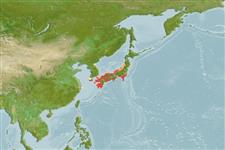>
Eupercaria/misc (Various families in series Eupercaria) >
Scaridae (Parrotfishes) > Sparisomatinae
Etymology: Calotomus: Greek, kalos, kallos = beautiful + Greek, tomos = section, cut (Ref. 45335).
More on author: Valenciennes.
Environment: milieu / climate zone / depth range / distribution range
Ökologie
seewasser riff-verbunden. Subtropical; 40°N - 30°N
Northwest Pacific: southern Japan, and at least as far as Tokyo, and the adjacent Asian mainland.
Size / Gewicht / Alter
Maturity: Lm ? range ? - ? cm
Max length : 39.0 cm TL Männchen/unbestimmt; (Ref. 9710)
Rückenflossenstacheln (insgesamt): 9; Rückenflossenweichstrahlen (insgesamt): 10; Afterflossenstacheln 3; Afterflossenweichstrahlen: 9 - 10; Wirbelzahl: 25. Flexible to semi-pungent dorsal spines; a dark central blotch on inter spinous membrane of dorsal spines I and II. Area circumscribed by pectoral fin unspotted. Rounded caudal fins at all sizes. Reddish brown in color when fresh with white and pale gray scale markings. Reddish pelvic fins with whitish blotches. Number of upper jaw teeth initially increasing with size. Yellow iris, blotched with dark brown. Lateral line interrupted.
Apparently confined to coastal waters in rocky areas with seaweeds (Ref. 9710).
Life cycle and mating behavior
Geschlechtsreife | Fortpflanzung | Ablaichen | Eier | Fecundity | Larven
Pelagic spawner.
Bruce, R.W. and J.E. Randall, 1985. A revision of the Indo-West Pacific parrotfish genera Calotomus and Leptoscarus (Scaridae: Sparisomatinae). Indo-Pac. Fish. (5):32 p. (Ref. 525)
IUCN Rote Liste Status (Ref. 130435)
Bedrohung für Menschen
Harmless
Nutzung durch Menschen
Fischereien: kommerziell; Sportfisch: ja
Mehr Information
ReferenzenAquakulturAquakultur ProfilZuchtlinienGenetikElectrophoresesVererbbarkeitKrankheitenVerarbeitungNutrientsMass conversion
PartnerBilderStamps, Coins Misc.LauteCiguateraGeschwindigkeitSchwimmstilKiemenoberflächeOtolithsGehirngrößeSehfähigkeit
Tools
Zusatzinformationen
Download XML
Internet Quellen
Estimates based on models
Preferred temperature (Ref.
123201): 17 - 22, mean 20.5 °C (based on 107 cells).
Phylogenetic diversity index (Ref.
82804): PD
50 = 0.5312 [Uniqueness, from 0.5 = low to 2.0 = high].
Bayesian length-weight: a=0.02089 (0.00803 - 0.05439), b=2.98 (2.75 - 3.21), in cm total length, based on LWR estimates for this (Sub)family-body shape (Ref.
93245).
Generation time: 3.9 ( na - na) years. Estimated as median ln(3)/K based on 1
growth studies.
Widerstandsfähigkeit (Ref.
120179): mittel, Verdopplung der Population dauert 1,4 - 4,4 Jahre. (Preliminary K or Fecundity.).
Fishing Vulnerability (Ref.
59153): Moderate vulnerability (36 of 100).
Nutrients (Ref.
124155): Calcium = 19 [6, 57] mg/100g; Iron = 0.532 [0.199, 1.358] mg/100g; Protein = 18.7 [16.5, 20.6] %; Omega3 = 0.0977 [, ] g/100g; Selenium = 7.61 [2.12, 26.73] μg/100g; VitaminA = 24.8 [5.2, 113.5] μg/100g; Zinc = 1.23 [0.57, 2.33] mg/100g (wet weight);
